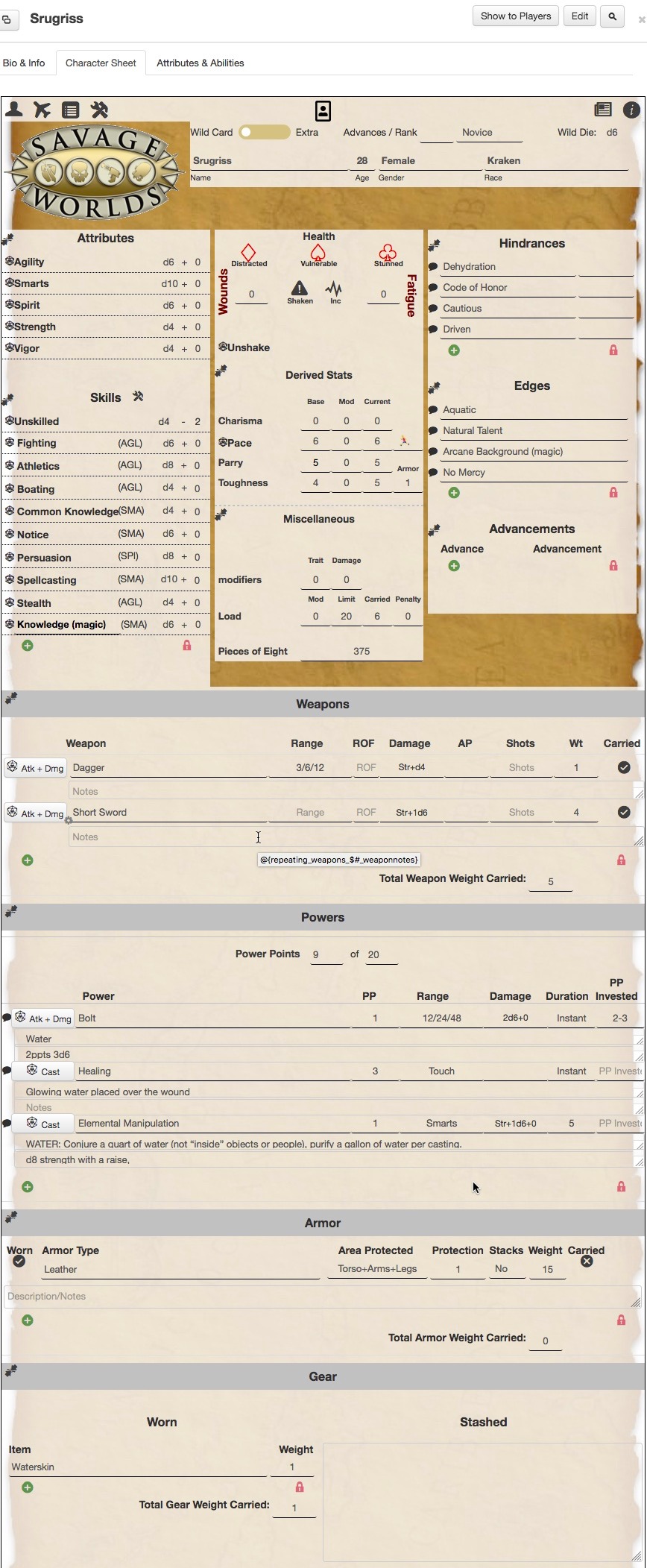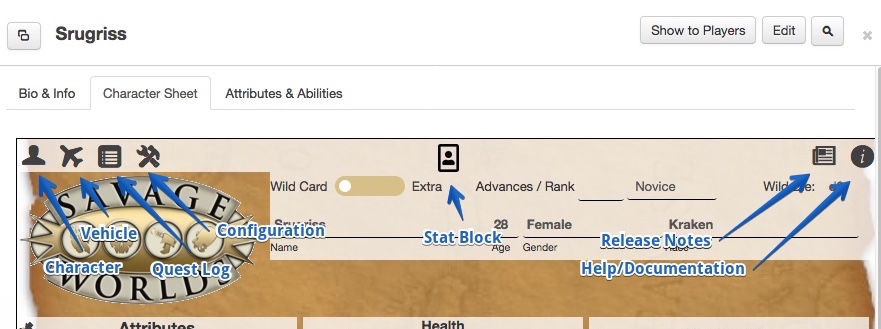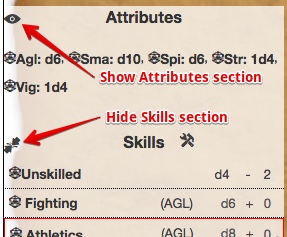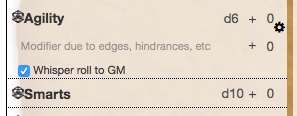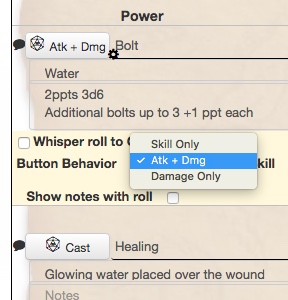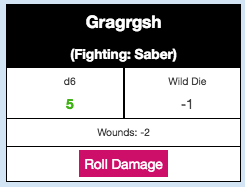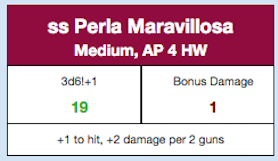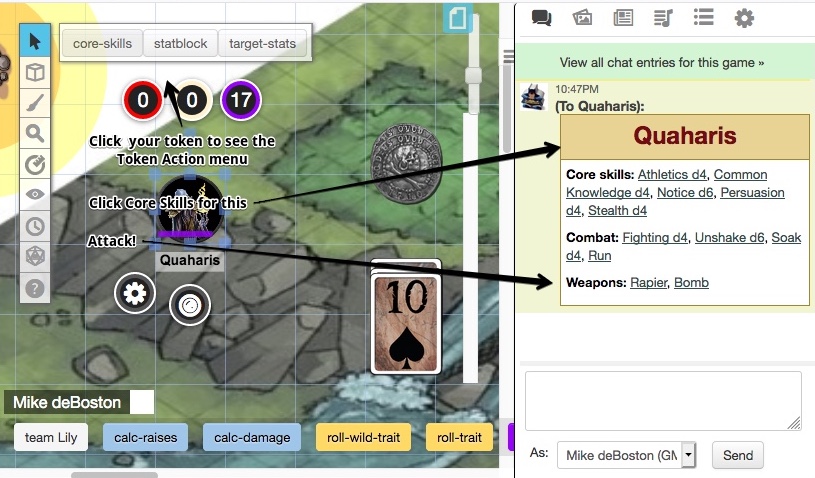Difference between revisions of "Savage Worlds Tabbed"
From Roll20 Wiki
Mike Combs (Talk | contribs) m (Added trademark weapon fighting and shooting) |
Mike Combs (Talk | contribs) m (→Shoot with Trademark Weapon Edge) |
||
| Line 247: | Line 247: | ||
* Getting the Wild Die, in case an edge makes it not d6 (like d8) `shootingWildDie` | * Getting the Wild Die, in case an edge makes it not d6 (like d8) `shootingWildDie` | ||
* Including modifiers for Distracted, Wounds, Fatigue, and Encumbrance `+@{selected|modSumEnc}` | * Including modifiers for Distracted, Wounds, Fatigue, and Encumbrance `+@{selected|modSumEnc}` | ||
| − | * Including modifiers | + | * Including modifiers from the traitMods on the character sheet `+@{selected|traitMods}` |
Revision as of 04:29, 5 July 2020
Intro
The Savage Worlds Tabbed Character Sheet (SW-TCS) tracks Wild Card characters, Extra characters, and vehicles for Savage Worlds by Pinnacle Entertainment Group. It supports the Core rules for Savage Worlds Deluxe (SWD) and Adventure Edition (SWADE), includes support for many popular settings, and allows for customization. It automatically calculates modifiers due to wounds, fatigue, and encumbrance, and provides buttons for trait, attack, damage, and other rolls.
- Original SW-TCS was created by G V.
- SW-TCS v3.x major update by Finderski.
- SW-TCS 4.x updated by Joseph M
- Character Sheet comments
- Character sheet on GitHub
- Wiki pages updated by Mike deBoston.
- Wiki Page comments
| As of April 2020, this page has had a major update to reflect the 4.x Character Sheet. |
Contents |
Major Feature Tabs
Buttons at the top access the major features of the sheet (called tabs).
- Character Tab--- For Wild Cards and Extras
- Vehicle Tab--- Attributes like Handling, Toughness, Top Speed, Crew
- Quest Log Tab--- Including personal appearance and community property
- Configuration Tab--- Customize skills, edges, rules, and design for a particular setting
- Stat Block--- Not really a tab. Outputs to chat, suitable for pasting into other applications
- Release Notes Tab
- Documentation Tab--- Find help here
Common Buttons
These character sheet conventions that apply throughout the character sheet.
Show/Shrink Buttons: Next to the section title, click the Shrink icon to hide the section (or shrink it to a summary). Click the Eye icon to show it again.
tRoll Buttons: Clicking the troll button will roll its associated trait, weapon, or power. Roll buttons can be dragged to the Macro quick bar at the bottom of the screen. You can make rolls public or visible only to the GM: Hover the item to reveal the settings (ygear) icon, then select Whisper roll to GM.
Here's the general formula for the roll buttons:
Highest of Rank die + Rank modifier, or Wild die + Trait Roll Modifier + Trait Test Modifier (or Damage Modifier for damage rolls) + Encumbrance Penalty (0 or negative for Agility & Strength-based rolls) - Wounds - Fatigue
Weapon and Power roll buttons are configurable (click the cog):
- Damage--- Rolls damage when clicked
- Atk + Dmg--- Rolls linked attack skill (like Fighting or Shooting) when clicked. The roll result has a button to roll damage. The linked skill is configurable.
- Atkx + Dmg--- Used for guns with RoF more than 1. Prompts for number of skill dice (max is the RoF) before rolling.
- Cast--- For powers, rolls linked skill like Faith or Spellcasting. The linked skill is configurable.
- The trait roll (left), is already adjusted for the modifiers shown on the next row.
- The Wild die (or Group/Crit Check) (right), is always rolled. If it's for an extra that doesn't need the crit check, just ignore it. It's rolled automatically to save time.
- Modifiers (2nd row) include Wounds, Fatigue, Encumbrance, and others.
- Roll Damage button (bottom row) is visible if the trait roll was made by clicking on a weapon or power.
- The damage roll (left), is already adjusted for modifiers. If there are any (like Wounds), they are shown in the next row
- The bonus damage roll (right), is always rolled. Use it if you got a raise on the attack roll or otherwise need it, or just ignore it.
- Notes are shown if entered in the weapon description
- Modifiers (next row, not shown)
Character Sheet Import & Export
There hasn't been a working character sheet import script for a long time. When it worked, it required a paid account. You could paste in a Stat Block, run the script, and it would populate all the Character Sheet fields.
With a paid account, you can move character sheets from one Roll20 game to another. As a GM, if you build a bestiary, this would be a way to re-use your work.
PEG announced impending support for Roll20. It's hoped that this will include Compendiums of ready-to-use maps, PCs, and NPCs and more. PEG, April 14, 2020.
You can easily output character data as a Stat Block in a format that many other sites will import.
Character Sheet Tab
The Character sheet tab contains all the data for a Savage Worlds character, and leverages the capabilities of Roll20 to auto-calculate derived stats (including Parry or cyberpunk Strain), calculate roll modifiers (including Wounds or encumbrance), and provide buttons for die rolls (including trait, power, and damage rolls).
The sheet includes every skill from the Savage Worlds Deluxe and Adventure editions plus a few popular skills such as: Faith, Guts, Rituals, Spellcasting, Psionics, and Weird Science. All skills except for Fighting are hidden by default allowing the player to select the skills they will be using.
Attributes
If you have a weapon or edge that modifies an attribute, click the cog and enter it in the 'modifier due to edges' field.
Skills
Click the Configure (wrench/hammer) icon to select from standard skills. You can add more skills to the standard list through the Configuration tab. You can add custom skills by clicking the + (plus) button at the bottom left. Custom skills can be linked to any attribute.
Health
Wounds, Fatigue, and Distracted will be applied as modifiers to trait rolls. Wounds and Fatigue are usually linked to Tokens (Bar 3 and Bar 1, respectively).
Derived Statistics
Parry and Toughness are calculated automatically, and Toughness includes modifiers from armor in the Armor section.
Size and Encumbrance can be enabled in the Configuration Tab.
Miscellaneous
The Trait and Damage modifiers will be applied to Trait and Damage rolls. Some players link these to Tokens (Bar 1 and Bar 2).
Load Limit Modifier - This helps calculate the Load Limit. The Load Limit is a calculated field and is the maximum weight a character can carry before becoming encumbered. The formula is:
(@{strength}+@{stMod}) * @{loadlimitmulitplier}
Total Load Carried - This is a calculated automatically as the sum of armor, weapons, and gear carried.
Advancements
Use this to record what was added with each advancement. If you increase a trait or add an edge, you should also record that in those sections; this is just a log. This section can be configured to appear on the Character or Journal page.
Weapons
The weapon button can be Damage, Attack + Damage, or if RoF is more than 1, AttackX + Damage.
The weapon will only show in the Stat Block and the weight will only be counted if carried (Carried button shows a checkmark).
The notes field is shown when rolling damage.
Powers
The configuration button (wrench/hammer) allows multiple Powers sections to support multiple arcance backgrounds (spell casting, psionics, etc.)
The trappings field is shown when the power is activated. The notes field can configured to also show at activation.
Power points are not automatically reduced when a power is activated. Many players link the power points field to Bar 2 on their token.
Armor
Armor weight is added to total weight if it is carried, even if it is not worn. If worn, the armor value is automatically added to Toughness.
Gear
The weight of gear that is worn is automatically added to total weight.
Augmentations
The Augmentation section can be enabled in the Configuration settings. This field is mainly intended for cyberpunk settings or any other setting that may use implants to enhance or extend the bodies capabilities, especially if those implants are mechanical in nature. This section is NOT a repeating section and there are a total of 12 different rows that a character can use, but they are show in groups of 4 rows. While this potentially adds to the clutter of the character sheet this approach was taken so that the Strain can be calculated and automatically applied to the Strain Derived Stat. Each Row in this section has three fields: Augmentation, Strain, and Details.
The initial view will display the first four rows. Below that block is a button to show another four rows. Clicking that button will display a second set of four rows (8 total will then be displayed). Below that block will be two buttons, one to hide 4 rows and one to add 4 more rows. Clicking the Hide 4 Rows buttons will hide the last 4 rows. Clicking the Add 4 Rows buttons will add 4 more rows and below that button will be a button to Hide 4 rows. This has the same functionality as the other Hide button, always hiding the last 4 rows. Hiding the rows does not erase the data, so if you had Strain values in those rows, the Strain stat will still be impacted.
Vehicle Sheet Tab
The Vehicle tab supports SWD and SWADE vehicles.
Configuration Tab
This section is where you can modify the sheet to fit a particular setting you may be playing. Settings are grouped into:
- Quick Setting Configuration--- This changes the other configuration settings as a group to match a setting.
- Backgrounds
- Logos
- Sheet Tweaks
- Derived Stats--- Stats selected here will be calculated and appear in the character tab. Examples: Corruption, Sanity.
- Field Name Replacements
- Skill Name Replacements
- Additional Setting Fields--- Fields selected here will appear in the character tab. Examples: Augmentations, Fencing Styles.
- Rules Modifications--- These change dice rolls, and derived stats. Examples: Gritty Damage, No Power Points, Use Wealth System.
All skills except Unskilled and Fighting are hidden (unselected) by default. Fighting is always visible, since it is necessary in calculating Parry.
Macros Without Programming
- No programming required!** The character sheet provides a lot of automation and you can easily move those buttons into the macro bar or Token Macro bar.
Turn Rolls Into Macros
You can make macros for rolls from the character sheet, so you don't have to open the character sheet for common things like rolls to notice, attack, or unshake.
- Open the Character Sheet
- Drag the d20 icon next to the roll down to your macro bar at the bottom of the screen
- This will add the macro but it will have a long name. Right click on the macro to rename it.
Turn Rolls Into Token Macros
You can make Token Macros for rolls from the character sheet. Token Macros appear in a menu at the top of the screen, only visible when you click on your token.
First, get the script for the macro:
- Open the Character Sheet.
- Click on the Roll button (dice icon) you'd like as a token macro. For example, choose the Damage roll for the first weapon. The dice will roll and you'll see the result in the chat window.
- Click in the chat window and press the Up Arrow key. The chat window will show the macro script (example below). Copy the text from the macro window. (Don't copy the example below, it won't work for you.)
damage macro example (built into character sheet)
&{template:damage} {{name=@{Ishmael|character_name}}} {{source=Shariha (Knife) }} {{dmg_rank=Str+1d4+0}} {{dmg_roll=[[@{Ishmael|strength_rank}+1d4!+0 + @{Ishmael|damagemods}]]}} {{bonus_die=[[@{Ishmael|vbonusdamage}]]}} {{showap=[[1d0+]]}} {{ap=}} {{notes=Improved Trademark Weapon, +2 hit, +1 parry. 3/6/12}} {{button=y}} {{DmgRoll=[Re-Roll Damage](~-LZkrQ6g_wBtlsu7Z4sM|repeating_weapons_-Lahy6h2MHL4mPqwHHzh_dmg) }}
Next, add an Ability (macro) to the token:
- Click back in the character sheet window and select the Attributes & Abilities tab.
- In the Abilities column, click the + Add button. A New Ability row will appear. Hover it and click the pencil icon. Give the macro a name like "Slash with knife".
- Paste the macro text into the main text box. Click the checkbox icon to finish.
- After you've closed the macro editing box, select Show as Token Action.
- Deselect the token. When you click to select it again, the token macro should appear.
Useful Token Macros
With a little scripting, you can make a menu With the SW-TCS you can save screen space and use macros to act without having to open the character sheet.
These scripts are mostly stored as Abilities in a character sheet named "player-macros", set so it Can Be Edited And Controlled By = All Players. Storing scripts in a character sheet (instead of the macro list) makes it possible to move all the macros to another game (with the transmogrifier) and edits affect all players.
Check Notice on Many Characters
notice-rolls (macro) prompts user to click on four tokens, then rolls Notice for each. By Mike deBoston
&{template:info} {{item=Notice Rolls}} {{@{target|Character 1|token_name}=Notice d@{target|Character 1|notice}, rolls [[@{target|Character 1|notice_rank} + @{target|Character 1|NoticeskillMod}+ @{target|Character 1|ModSum}[Distracted, Wounds, Fatigue] + @{target|Character 1|traitmods}]].}} {{@{target|Character 2|token_name} =Notice d@{target|Character 2|notice}, rolls [[@{target|Character 2|notice_rank} + @{target|Character 2|NoticeskillMod}+ @{target|Character 2|ModSum}[Distracted, Wounds, Fatigue] + @{target|Character 2|traitmods}]].}} {{@{target|Character 3|token_name}=Notice d@{target|Character 3|notice}, rolls [[@{target|Character 3|notice_rank} + @{target|Character 3|NoticeskillMod}+ @{target|Character 3|ModSum}[Distracted, Wounds, Fatigue] + @{target|Character 3|traitmods}]].}} {{@{target|Character 4|token_name}=Notice d@{target|Character 4|notice}, rolls [[@{target|Character 4|notice_rank} + @{target|Character 4|NoticeskillMod}+ @{target|Character 4|ModSum}[Distracted, Wounds, Fatigue] + @{target|Character 4|traitmods}]].}}
Character Sheet Core Skills Menu
You can make a menu that appears in the chat window with character sheet rolls and other information; this helps players play faster by not having to open their character sheet and by reducing the options.
These macros are created in a character sheet named "player-macros" so that they can be easily moved to other games with the Transmogrifier (a Pro feature).
| To make the core-skills token macro work, you have to enter all four macros here. |
core-skills (a token macro, visible to all players)
%{player-macros|core-menu}
core-menu (ability in character sheet player-macros) This displays a short menu in the Chat window of common rolls from the character sheet. By Mike deBoston
/w @{selected|token_name} &{template:info} {{name=@{selected|character_name}}}{{Core skills= [Athletics @{selected|athletics_display}](~selected|tAthleticsRoll), [Common Knowledge @{selected|commonknowledge_display}](~selected|tCommonKnowledgeRoll), [Notice @{selected|notice_display}](~selected|tNoticeRoll), [Persuasion @{selected|persuasion_display}](~selected|tPersuasionRoll), [Stealth @{selected|stealth_display}](~selected|tStealthRoll) }} {{Combat=[Fighting @{selected|fighting_display}](~selected|tFightingRoll), [Unshake @{selected|spirit_display}](~selected|unshakeRoll), [Soak @{selected|vigor_display}](~selected|tVigorRoll), [Run](~selected|runningRoll) }} {{Weapons=[@{selected|repeating_weapons_$0_weapon}](~player-macros|roll-weapon-0), [@{selected|repeating_weapons_$1_weapon}](~player-macros|roll-weapon-1) }}
roll-weapon-0 (ability in character sheet player-macros)
@{selected|repeating_weapons_$0_weaponroll}
roll-weapon-1 (ability in character sheet player-macros)
@{selected|repeating_weapons_$1_weaponroll}
Shoot with Trademark Weapon Edge
This macro is handy but it's also a good example of many elements you can use in other macros:
- The Roll Template
- Getting the trait die and trait modifier (like d12+2) `shooting_rank`
- Getting just the trait modifier (like +2) `shootingMod`
- Getting the additional trait modifier from an edge (like +1) `shootingSkillMod`
- Getting the Wild Die, in case an edge makes it not d6 (like d8) `shootingWildDie`
- Including modifiers for Distracted, Wounds, Fatigue, and Encumbrance `+@{selected|modSumEnc}`
- Including modifiers from the traitMods on the character sheet `+@{selected|traitMods}`
trademark-fighting (ability in character sheet player-macros) This macro adds +1 to fighting trait rolls with the first weapon in the character's list. By Mike deBoston
&{noerror} &{template:roll} {{name=@{selected|token_name}}} {{trait=@{selected|fightingName}}} {{source=@{selected|repeating_weapons_$0_weapon}}} {{skill_rank=@{selected|fighting_rank}+@{selected|fightingSkillMod}+1[tm]}} {{skill_roll=[[@{selected|fighting_rank}+@{selected|fightingSkillMod}+@{selected|modSumEnc}[Distracted, Wounds, Fatigue, Encumbrance]+@{selected|traitMods}+1[trademark]]]}} {{mook=[[1d0+1]]}} {{wild_die=[[@{selected|fightingWildDie}+@{selected|fightingMod}+@{selected|fightingSkillMod}+@{selected|modSumEnc}[Distracted, Wounds, Fatigue, Encumbrance]+@{selected|traitMods}+1[tm]]]}} {{button=y}} {{DmgRoll=[Roll Damage](~@{selected|repeating_weapons_$0_dmg}) }} @{selected|setmodsenc} @{selected|showTraitMods}
trademark-shooting (ability in character sheet player-macros) This macro adds +1 to shooting trait rolls with the first weapon in the character's list. By Mike deBoston
&{noerror} &{template:roll} {{name=@{selected|token_name}}} {{trait=@{selected|shootingName}}} {{source=@{selected|repeating_weapons_$0_weapon}}} {{skill_rank=@{selected|shooting_rank}+@{selected|shootingSkillMod}+1[tm]}} {{skill_roll=[[@{selected|shooting_rank}+@{selected|shootingSkillMod}+@{selected|modSumEnc}[Distracted, Wounds, Fatigue, Encumbrance]+@{selected|traitMods}+1[trademark]]]}} {{mook=[[1d0+1]]}} {{wild_die=[[@{selected|shootingWildDie}+@{selected|shootingMod}+@{selected|shootingSkillMod}+@{selected|modSumEnc}[Distracted, Wounds, Fatigue, Encumbrance]+@{selected|traitMods}+1[tm]]]}} {{button=y}} {{DmgRoll=[Roll Damage](~@{selected|repeating_weapons_$0_dmg}) }} @{selected|setmodsenc} @{selected|showTraitMods}
Creating Your Own Macros
All of the formulas used for the Trait roll buttons follow the same basic formula, shown in this Agility example:
This is the basic formula for traits that aren't linked to Agility, like Notice. It doesn't factor in Encumbrance, but it factors in Distracted, Wounds, and Fatigue. This makes scripts that roll Notice look a little more complicated than they really are.
[[@{notice_rank} + @{NoticeskillMod}+ @{ModSum}[Distracted, Wounds, Fatigue] + @{traitmods}]]
This is the basic formula for Agility and Agility-linked traits like Fighting. It takes into account Encumbrance.
[[@{fighting_rank} + @{FightingskillMod}+ @{ModSumEnc}[Distracted, Wounds, Fatigue, Encumbrance] + @{traitmods}]]
Agility Roll Formula:
/em @{character_name} attempts to be agile and rolls [[{1d@{agility}![Agility], 1d@{wilddie}![Wild Die]}kh1 + @{agMod}[Agility Rank Modifier] + @{agrollMod}[Agility Roll Modifier] + @{ttmod}[Trait Test Modifiers] + @{encumbrance}[Encumbrance Penalty] - @{woundsMod}[Wounds] - @{fatigue}[Fatigue]]]
Shortcuts for Creating Macros
The tabbed character sheet has a lot of hidden fields that you can reference in your own macros.
For Attributes and built-in Skills, hover over the attribute or skill and you'll see a tooltip like @{tAgility} or @{tAthletics}. When you create a new Ability (macro) as above, just use enter something like %{selected|tAgilityRoll} or %{selected|tAthleticsRoll}.
Hidden Fields:
These fields are hidden but available to make it easier to make your own macros:
| Field Name | Ability Macro Text |
|---|---|
| rollAgility | @{rollAgility} |
| rollSmarts | @{rollSmarts} |
| rollSpirit | @{rollSpirit} |
| rollStrength | @{rollStrength} |
| rollVigor | @{rollVigor} |
The Ability macro text does not need to be enclosed in double square brackets, nor does it require a /r or /roll, because the value of each field is already a roll. Creating that macro will roll exactly as if the roll button next to each Attribute had been pressed.
Roll Templates
When you click on the character sheet for a Trait roll, the output in the Chat window is formatted by a Roll Template. When you click on the sheet for a damage roll, the output is formatted by the Damage roll template. There are many Roll Templates available and you can use them to format the output from your own macros.
- Roll--- A black 2-column table used for Trait rolls
- Damage--- A red 2-column table used for damage rolls
- Info--- A tan 1-column table with a text field
- Description--- A black 1-column table with a text field
- Unshake--- Uses emote (italic, tan text) with a roll to unshake.
- Running--- Uses emote with text and a roll to run.
- Consumables
- Emote--- Italic, tan text on a tan background.
- Gritty
- Statblock--- A tan 1-column table with many fields for a complete Stat Block.
Use a template by specifying the name followed by a series of field/value pairs.
example-roll-template
&{template:roll} {{name=Mike the Portal Maker}} {{trait=Open Portal}} {{source=Spirit}} {{skill_rank=d6}} {{skill_roll=[[1d6!]]}} {{mook=[[1d0+1]]}} {{wild_die=[[1d6!]]}}
The mook field needs a 0 or 1 value, you should enter either 1d0 or 1d0+1.
Most templates have a set of fields you can use. The Info template is unique; you can send any field name you'd like and it will show in the output.
Damage Roll Template
This will put a 'Reroll' button at the bottom of the damage template. Be sure to change the part that says '~test|Work-the-room' to the name of the character sheet and name of the macro you add this to.
{{button=y}} {{DmgRoll=[Reroll](~test|Work-the-room)}}
Optional fields for Trait Roll Template usage:
| Template Field | Description |
|---|---|
| {{skill_roll(2-4)}} | Additional options for more trait tests, to support multi-action and/or Frenzy type actions. |
| {{skill_name(2-4)}} | Additional options for more trait tests, to support multi-action and/or Frenzy type actions. |
| {{skill_rank}} | The die rank of the Trait (skill or attribute). |
| {{skill_rank(2-4) | Additional options for more trait tests, to support multi-action and/or Frenzy type actions. |
| {{skill_rank_mod}} | The die rank modifier of the Trait (skill or attribute). |
| {{skill_rank_mod(2-4) | Additional options for more trait tests, to support multi-action and/or Frenzy type actions. |
| {{wild_die}} | The formula used for the actual Wild Die roll. Must be done as an inline roll. |
| {{wild_die(2-4) | Additional options for more trait tests, to support multi-action and/or Frenzy type actions. |
| {{wild_die_rank}} | The Wild Die die-type. |
| {{wild_die_rank(2-4) | Additional options for more trait tests, to support multi-action and/or Frenzy type actions. |
| {{enc}} | Encumbrance penalty |
| {{wounds}} | The number of wounds for the character |
| {{fatigue}} | The number of Fatigue levels for the character |
| {{att_mod}} | The Attribute Roll Modifier |
| {{skill_mod}} | The Skill Roll Modifier |
| {{ttmod}} | Situational Roll Modifier |
| {{sit_notes}} | Situational Modifier Notes (can be used to list all the situational modifiers that equal the one modifier value) |
| {{bonuses}} | Generic field for blanket bonuses |
| {{penalties}} | Generic field for blank penalties |
| {{notes}} | Generic field for notes |
Example of usage: &{template:solidtrait} {{name=@{character_name}}} {{skill_name=Agility}} {{skill_rank=@{Agility}}} {{skill_rank_mod=@{agMod}}} {{att_mod=@{agrollMod}}} {{ttmod=@{ttmod}}} {{wounds= -@{wounds}}} {{fatigue= -@{fatigue}}} {{skill_roll=[[1d@{agility}! + @{agMod} + @{agrollMod}[Skill Modifier] + @{ModSum}[Other Modifiers]]}} {{wild_die_rank=@{wilddie}}} {{wild_die=[[1d@{wilddie}! + @{agMod} + @{agrollMod}[Skill Modifier] + @{ModSum}[Other Modifiers]]}}
| The roll templates will break if any of the fields called aren't properly filled out. This is most likely to occur with roll templates used in conjunction with repeating sections. |
For example, if you are using a roll template for a damage roll and calling the fields from one of the repeating weapons selection, ALL fields for that weapon will have to be explicitly initialized (i.e. you will need to make sure that you have entered a value in every field at least once--even if a value was already there when the weapon was created (default values do not initialize fields in repeating sections, so you will need to enter each field and hit enter to ensure that the values are activated). If field information is missing, the roll template results will not be what you expect.
Planned Enhancements & Wishlist
As of April 2020, discussion of features and bugs is in the [SWT Test Game v4 and later].





